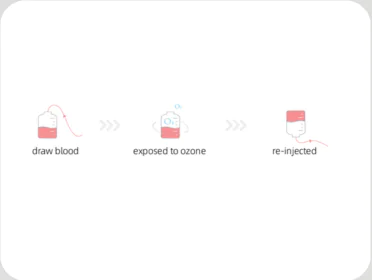
Ozone Therapy
_____________________________

Schedule Consultation

Schedule Consultation

Ozone Therapy entails infusing the body with carefully measured amounts of ozone gas, typically mixed with oxygen or sterile saline before being injected or administered using a thin catheter into tissues via injection or infiltration. Common sites for administering ozone therapy include vaginal and rectal areas; however, it can also penetrate deeper through intramuscular, subcutaneous, and intravenous lines.
Autohemotherapy is another widely practiced technique. A small amount of blood is drawn out and gently mixed with ozone gas before being reinfused back into the body. Practitioners believe this helps distribute ozone throughout the system, oxidizing and inactivating microorganisms while clearing away necrotic tissue, excess lipids, and pathogen-released toxins.
Researchers and clinicians alike have explored ozone therapy as a potential treatment option for tumors, cardiovascular conditions, and chronic infections such as diabetic foot ulcers. Some individuals report experiencing swelling relief following treatment. However, due to limited clinical trial data, it’s advisable to await more evidence before giving this therapy widespread approval.
Ozone therapy stands out as an excellent oxidizer, eliminating organic material like viruses, bacteria, and rapidly proliferating cancer cells from the body. Once this first round of oxidation clears away damaged targets, a second wave may encourage new blood vessel growth, increase energy output in mitochondria, and stimulate white blood cell activity for improved immunity.
Recent studies demonstrate ozone’s ability to increase oxygen levels both in the bloodstream and within tumors, providing cancer cells with additional oxygen that can make them more vulnerable to chemotherapy and radiation therapy.
Animal trials have shown that breathing small doses of ozone can temporarily increase antioxidant enzyme production, aiding cells in clearing metabolic waste and protecting against oxidative damage. This enhances general immunity and selective defense mechanisms specifically directed against tumors.
Clinicians using ozone therapy have observed improved blood perfusion to organs like the liver and kidneys, even during chemotherapy. By expediting drug breakdown and clearance, ozone therapy can reduce treatment-related side effects and discomfort in these organs.
Rationale of Ozone Therapy
The first aim of ozone therapy is removal — stimulating phagocytosis by neutrophils and monocytes to clear metabolic debris, microbial pathogens, and circulating toxins from the bloodstream.
The second aim is activation — ozone exposure energizes lymphocytes, activates functional proteins, and enhances antioxidant enzyme systems, leading to a more responsive immune defense.
The third aim is improvement in blood mechanics — ozone lowers blood viscosity, restores normal flow dynamics, and enhances microcirculation. These changes reduce the workload on blood vessel walls and promote softer, more flexible arteries.
Indications
Ozone therapy has emerged as a noninvasive and innovative form of oncological care, offering painless treatment with minimal side effects and toxicity. It has also been used beyond tumor therapy, showing value in:
- Cerebral thrombosis
- Active diabetes
- Resistant gout
- Chronic infections and inflammation
- Cardiovascular disorders
- Diabetic foot ulcers
- Immunosuppressed patients who struggle to recover with conventional protocols
- Tumors resistant to chemotherapy or radiation therapy — ozone’s oxidative pressure can heighten cancer cell sensitivity to cytotoxic agents
Our Specialties & Procedures
Explore our range of advanced cancer care procedures designed to provide comprehensive treatment and improve your well-being.
Advanced Therapies For Cancer
Innovative and precise cancer treatments combining advanced technology, targeted therapy, and personalized medicine for better recovery outcomes.
Explore More →Treating Specific Cancer
Specialized treatment plans for different cancer types — including liver, lung, breast, and bone cancers — with a focus on patient comfort and long-term wellness.
Explore More →Our Specialties & Procedures
Explore our range of advanced cancer care procedures designed to provide comprehensive treatment and improve your well-being.
Advanced Therapies For Cancer
Innovative and precise cancer treatments combining advanced technology, targeted therapy, and personalized medicine for better recovery outcomes.
Explore More →Treating Specific Cancer
Specialized treatment plans for different cancer types — including liver, lung, breast, and bone cancers — with a focus on patient comfort and long-term wellness.
Explore More →ABOUT FUDA CANCER HOSPITAL
OUR ACHIEVEMENTS
Achievements of FUDA CANCER HOSPITAL
50+ Doctors
Professional Experts
1200+ Patients
Happy Indian Patients
100+ Countries
Global Presence
500+ Employees
Dedicated Workforce
Advanced Therapies for Cancer of All Stages
Nano Knife IRE (Irreversible Electroporation)
Cryotherapy | Cryosurgery | Cryo-ablation
Brachytherapy for Cancer
Microvascular Interventional Chemotherapy
Patient Testimonials
Mrs. Pratibha Rajgopal
Mrs. Dipikabehan Parmar
Mrs. Roseline Chandran
Mrs. Jyoti Bhatia
Ozone Therapy – FAQs (Fuda Cancer Hospital)
1. Removal: Stimulates phagocytosis by immune cells, clearing toxins and metabolic waste.
2. Activation: Boosts lymphocyte activity and enhances antioxidant enzyme systems for stronger immune responses.
3. Circulatory Improvement: Reduces blood viscosity and improves microcirculation, leading to better tissue oxygenation and vascular flexibility.
